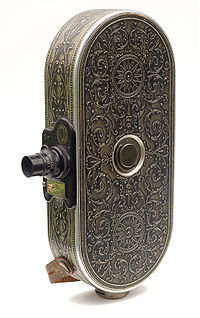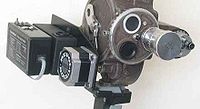
Filmo
Encyclopedia
Filmo is a series of 16-mm movie equipment made by the Bell & Howell Company. The line included cameras, projectors and accessories.
) into Kodak
's 16mm plans in 1920, the company was quick to see the advantages and immediately set about redesigning the 17.5mm camera for 16mm film.
The Filmo 70 was the first spring motor-driven 16mm camera. In 1925 the Eyemo
, a hand-held 35mm camera based on the design of the Filmo 70 was offered. It was also spring driven, but could be hand-cranked as well. Bell & Howell introduced the first 16mm turret camera with its Model C in 1927. A beautifully ornate and much more compact 16mm camera, the Filmo 75, marketed primarily as a "watch-thin" ladies' camera, was offered in 1928, followed in 1931 by a nearly identical counterpart designated as the Filmo Field Camera, offered initially in a plain covering, but also available with the ornate decorations of the Model 75, and in that form indistinguishable from the earlier version except for the nameplate.
When Kodak introduced 8mm film in 1932, Bell & Howell was slow to take up the new format, and when it did so, it was not in the form of the Kodak standard. The first 8mm Filmo was offered in 1935 as a single-8 camera, the Filmo 127-A. However, single-8 did not appeal to the market as well as double-8, so the design was modified for double-8 as the 134-A in 1936. Production of Filmos around this body type continued into the 1950s.

 The 16mm Filmo cameras all take 16-mm film on a 100 ft (30.5 m) Daylight spool although some versions can also take 400 ft (121.9 m) external magazines.
The 16mm Filmo cameras all take 16-mm film on a 100 ft (30.5 m) Daylight spool although some versions can also take 400 ft (121.9 m) external magazines.
Spring wind is standard, although some Filmos have provisions for attachment of a 12V DC
or AC
motor. A crystal-sync motor was developed for the Eyemo
and later adapted to the Filmo.
The Camera is configured for C mount
lenses and starting in 1927, was equipped with a three lens turret (Model C). Early turret models used a variable drum finder (Models D and DA) or sets of separate finder lenses matched to each focal length on later cameras (Models DL and DR).
Early versions (The Filmo 70A and 70C) were designed for two speeds, either 8 and 16 frame/s, or 16 and 32 frame/s, with one option for a 12-16-24 frame/s 3-speed camera. Starting with the Model D in 1927, most versions could shoot a range of speeds up to 64 frames per second (8-12-16-24-32-48-64 frame/s), although there was a superspeed version, the 70-B (1925), designed to run at a single speed of 128 frame/s. This produced an extreme slow-motion effect and was used for motion analysis. The Model 70-E (1935) was a turretless version of the Model D, with a shorter range of speeds (8-16-24-64 frame/s).
The camera was built to the most precise standards in the industry, and is still popular with student filmmakers. Most varieties are very common, but special models like the Model 70-B, and the 70-DB (Golf Model, 1931)) are quite rare, and the Filmo 70-AC Morgana Color System camera (1932), while advertised briefly, is unknown in any extant examples and may never have gone past the prototype stage.
History
The Filmo camera series started with the 1923 Filmo 70, beginning a series of models built on the same basic body that was to continued for more than half a century. It was based on Bell & Howell's brilliantly designed 1917 prototype for a 17.5mm camera intended for amateur use. When invited (along with VictorVictor Animatograph Corporation
The Victor Animatograph Corporation was a maker of projection equipment founded in 1910 in Davenport, Iowa.The firm made its first 16 mm camera and movie projector in 1923, the same year Eastman Kodak introduced the Cine-Kodak and Kodascope...
) into Kodak
Eastman Kodak
Eastman Kodak Company is a multinational imaging and photographic equipment, materials and services company headquarted in Rochester, New York, United States. It was founded by George Eastman in 1892....
's 16mm plans in 1920, the company was quick to see the advantages and immediately set about redesigning the 17.5mm camera for 16mm film.
The Filmo 70 was the first spring motor-driven 16mm camera. In 1925 the Eyemo
Eyemo
The Eyemo is a 35 mm motion-picture film camera which was manufactured by the Bell & Howell Co. of Chicago.-Background:Designed and first manufactured in 1925, it was for many years the most compact 35 mm motion-picture film camera of the hundred foot capacity...
, a hand-held 35mm camera based on the design of the Filmo 70 was offered. It was also spring driven, but could be hand-cranked as well. Bell & Howell introduced the first 16mm turret camera with its Model C in 1927. A beautifully ornate and much more compact 16mm camera, the Filmo 75, marketed primarily as a "watch-thin" ladies' camera, was offered in 1928, followed in 1931 by a nearly identical counterpart designated as the Filmo Field Camera, offered initially in a plain covering, but also available with the ornate decorations of the Model 75, and in that form indistinguishable from the earlier version except for the nameplate.
When Kodak introduced 8mm film in 1932, Bell & Howell was slow to take up the new format, and when it did so, it was not in the form of the Kodak standard. The first 8mm Filmo was offered in 1935 as a single-8 camera, the Filmo 127-A. However, single-8 did not appeal to the market as well as double-8, so the design was modified for double-8 as the 134-A in 1936. Production of Filmos around this body type continued into the 1950s.
Description


Spring wind is standard, although some Filmos have provisions for attachment of a 12V DC
Direct current
Direct current is the unidirectional flow of electric charge. Direct current is produced by such sources as batteries, thermocouples, solar cells, and commutator-type electric machines of the dynamo type. Direct current may flow in a conductor such as a wire, but can also flow through...
or AC
Alternating current
In alternating current the movement of electric charge periodically reverses direction. In direct current , the flow of electric charge is only in one direction....
motor. A crystal-sync motor was developed for the Eyemo
Eyemo
The Eyemo is a 35 mm motion-picture film camera which was manufactured by the Bell & Howell Co. of Chicago.-Background:Designed and first manufactured in 1925, it was for many years the most compact 35 mm motion-picture film camera of the hundred foot capacity...
and later adapted to the Filmo.
The Camera is configured for C mount
C mount
A C mount is a type of lens mount commonly found on 16mm movie cameras, closed-circuit television cameras, and trinocular microscope phototubes....
lenses and starting in 1927, was equipped with a three lens turret (Model C). Early turret models used a variable drum finder (Models D and DA) or sets of separate finder lenses matched to each focal length on later cameras (Models DL and DR).
Early versions (The Filmo 70A and 70C) were designed for two speeds, either 8 and 16 frame/s, or 16 and 32 frame/s, with one option for a 12-16-24 frame/s 3-speed camera. Starting with the Model D in 1927, most versions could shoot a range of speeds up to 64 frames per second (8-12-16-24-32-48-64 frame/s), although there was a superspeed version, the 70-B (1925), designed to run at a single speed of 128 frame/s. This produced an extreme slow-motion effect and was used for motion analysis. The Model 70-E (1935) was a turretless version of the Model D, with a shorter range of speeds (8-16-24-64 frame/s).
The camera was built to the most precise standards in the industry, and is still popular with student filmmakers. Most varieties are very common, but special models like the Model 70-B, and the 70-DB (Golf Model, 1931)) are quite rare, and the Filmo 70-AC Morgana Color System camera (1932), while advertised briefly, is unknown in any extant examples and may never have gone past the prototype stage.

